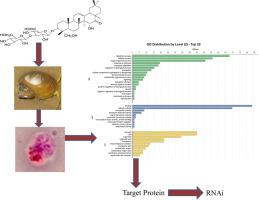Ecotoxicology and Environmental Safety ( IF 6.8 ) Pub Date : 2021-06-05 , DOI: 10.1016/j.ecoenv.2021.112393 Chunping Yang 1 , Yangyang Zhang 1 , Yue Zhou 1 , Huabao Chen 1 , Tianxing Lv 1 , Liya Luo 1 , Xiaoyan Qiu 1 , Min Zhang 1 , Guangwei Qin 1 , Guoshu Gong 1

|
Previous study found that pedunsaponin A (PA) influenced the cytoskeleton of Pomacea canaliculata hemocytes, leading to depolarization and haemocyte destruction and eventually to snail death. In this study, we analysed the changes in protein expression by iTRAQ-mediated proteomics and identified 51 downregulated proteins. Among these, we focused on proteins related to cytoskeletal function and identified neural Wiskott-Aldrich syndrome isoform X1 (PcnWAS). The full-length PcnWAS gene contains 9791 bp and includes an open reading frame of 1401 bp that encodes 735 amino acids with a predicted molecular mass of 49.83 kD. PcnWAS exhibited a relatively distant genetic relationship with known species; the closest homologue is Biomphalaria glabrata (57%). RNA interference (RNAi) was adopted to verify the function of PcnWAS after screening the siRNA sequence with an efficiency of 97%. Interference with the gene expression of PcnWAS did not lead to snail death, but the depolarization level increased, which demonstrated that PcnWAS is an important depolarization-related protein. The results of PA treatment of snails subjected to RNAi proved that interfering with PcnWAS gene expression decreased the molluscicidal activity of PA toward P. canaliculata; snail mortality after RNAi was significantly lower (40%) than that in PA-treated snails without RNAi (54%), while the survival rate and depolarization level in haemocytes were not significant, indicating that PcnWAS is only one of the important target proteins of PA in P. canaliculata. This study lays the foundation for further exploration of the molecular mechanism by which PA kills this harmful snail.
中文翻译:

芍药苷 A 杀灭Pomacea canaliculata靶蛋白的筛选及功能验证
之前的研究发现,胡瓜皂苷 A (PA) 影响Pomacea canaliculata血细胞的细胞骨架,导致去极化和血细胞破坏,最终导致蜗牛死亡。在这项研究中,我们通过 iTRAQ 介导的蛋白质组学分析了蛋白质表达的变化,并鉴定了 51 个下调的蛋白质。其中,我们专注于与细胞骨架功能相关的蛋白质,并鉴定了神经 Wiskott-Aldrich 综合征同种型 X1 ( PcnWAS )。全长PcnWAS基因包含 9791 bp,包括一个 1401 bp 的开放阅读框,编码 735 个氨基酸,预测分子量为 49.83 kD。PcnWAS与已知物种表现出相对较远的亲缘关系;最接近的同源物是Biomphalaria glabrata (57%)。筛选siRNA序列后,采用RNA干扰(RNAi)验证PcnWAS的功能,效率为97%。干扰PcnWAS基因表达并未导致蜗牛死亡,但去极化水平升高,说明PcnWAS是一种重要的去极化相关蛋白。PA 处理接受 RNAi 的蜗牛的结果证明干扰PcnWAS基因表达会降低 PA 对P. canaliculata的杀软体动物活性; RNAi 后的蜗牛死亡率(40%)显着低于 PA 处理的没有 RNAi 的蜗牛(54%),而血细胞的存活率和去极化水平不显着,表明PcnWAS只是其重要的靶蛋白之一。P. canaliculata 中的PA 。该研究为进一步探索PA杀死这种有害蜗牛的分子机制奠定了基础。


























 京公网安备 11010802027423号
京公网安备 11010802027423号